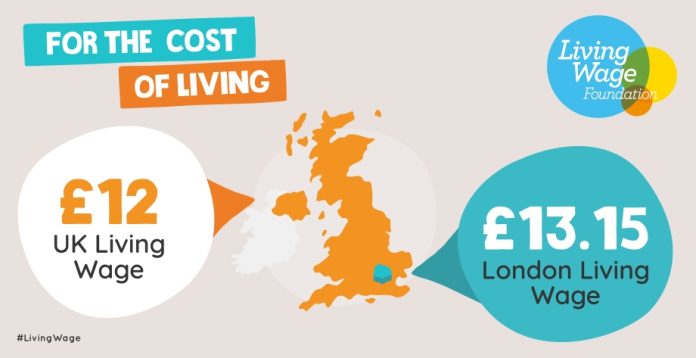Over 460,000 people working for 14,000 real Living Wage Employers throughout the country are set for a vital cost-of-living pay boost, as the Living Wage Foundation’s real Living Wage rates rise to £12 an hour across the UK (£1.10 increase), and £13.15 an hour in London (£1.20 increase).
The real Living Wage, set by the Living Wage Foundation, remains the only wage rates independently calculated based on what people need to live on. This year the rate increased by 10% in the UK, reflecting persistently high costs for low paid workers.
Recent research by the Living Wage Foundation shows that despite inflation easing, the cost-of-living crisis is far from over for Britain’s 3.5m low paid workers. Recent polling of those earning below the real Living Wage found that 60% have visited a food bank in the past year and 39% regularly skipping meals for financial reasons.
Unlike the Government minimum wage (‘National Living Wage’ for over 23s – £10.42) the real Living Wage is the only wage rate independently calculated based on rising living costs and applies to everyone over 18.
A full-time worker earning the new, real Living Wage would earn £3,081 a year more than a worker earning the current government minimum (NLW), and £2,145 more than their current pay. In London, a full-time worker on the new real Living Wage rate would earn an additional £5323.50 a year compared to a worker on the current NLW
Brett Mendell, Director at Thomas Kneale, a Living Wage Employer and textiles company based in Manchester, said:
“People are our biggest asset, and paying the real Living Wage and above has significant benefit to both our colleagues and to the company. Our team report lower stress and reduced financial anxiety, a higher standard of living, and a lift in morale. We have also seen productivity improvements while delivering a labour turnover reduction of 60% and a staff absence decrease of 75% since we became accredited in 2015. We’re also a Living Hours accredited employer, so our team also has security of hours along with other benefits.”
There are 3.5m jobs (12.2% of employee jobs, or 1 in 8 jobs) paid less than the real Living Wage. According to Living Wage Foundation projections, the scale of low pay is predicted to increase to 4.3m (15.7% of jobs) in 2023.
Recent research published by the Living Wage Foundation found that despite easing inflation, the cost of living crisis is far from over for low paid workers, with 50% worse off than a year ago. 43% of low paid workers reported regularly using a foodbank (at least once per month), 60% have used a foodbank in the past year and 39% reported falling behind on household bills.
UNISON general secretary Christina McAnea said:
“This is good news for hundreds of thousands of low-paid workers whose employers do the right thing. That’s pay them a decent wage. But many more providing essential public services will miss out.
“These employees include care workers, who’re often on poverty pay, in a sector already struggling to fill record vacancies.
“And today’s increase means thousands of workers employed by the NHS on the lowest pay bands – like porters, cleaners, domestics and security staff – will be significantly short of the new rate.
“The government must follow suit and boost the minimum wage so millions are better able to weather the cost of living pressures causing such deep financial pain.”







